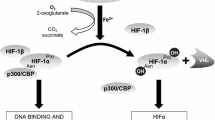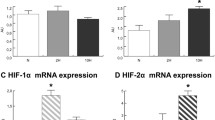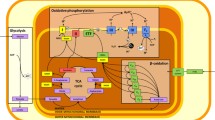Abstract
Although CO2 is produced during the oxidation of different substrates in all types of cells, the role of this gas in the regulation of cellular function is not clearly understood. Since changes in several signal transduction as well as apoptotic, anti-apoptotic, and other proteins are known to modify cellular function, we investigated if some of these proteins are altered upon incubating the rat hind leg skeletal muscle in a medium enriched with CO2 (1000–1200 ppm) for 30 min. CO2 was observed to depress phosphorylated levels of ERK1 (P44) and ERK2 (P42) without affecting the unphosphorylated content of these MAPK proteins. On the other hand, no change in p38 MAPK protein was found but the content of its degradation product 30 kDa proteins (both phosphorylated and unphosphorylated) was decreased. No alterations in the content of other signaling proteins (PKA and Akt), inflammatory molecule (TNF-α), and vascular endothelial growth factor (VEGF) were seen upon exposure of the muscle to CO2. The content for apoptotic and anti-apoptotic proteins (Bad and Bcl2), except for a decrease in caspase 3, were also not affected by CO2. These results indicate that CO2 may serve as a gasotransmitter to regulate cellular function by depressing MAPK and caspase 3 activities.



Similar content being viewed by others
References
Moncada S, Palmer RM, Higgs EA (1991) Nitric oxide: physiology, pathophysiology and pharmacology. Pharmacol Rev 43:109–142
Li L, Hsu A, Moore PK (2009) Actions and interactions of nitric oxide, carbon monoxide and hydrogen sulphide in the cardiovascular system and in inflammation—a tale of three gases! Pharmacol Ther 123:386–400
Verma A, Hirsch DJ, Glatt CE, Ronnett GV, Snyder SH (1993) Carbon monoxide: a putative neural messenger. Science 259:3818–3840
Yong QC, Cheong JL, Hua F, Deng LW, Khoo YM, Lee HS, Perry A, Wood M, Whiteman M, Bian JS (2011) Regulation of heart function by endogenous gaseous mediators-crosstalk between nitric oxide and hydrogen sulfide. Antioxid Redox Signal 14:2081–2091
Veeranki S, Tyagi SC (2015) Role of hydrogen sulfide in skeletal muscle biology and metabolism. Nitric Oxide 46:66–71
Radawski D, Dabney JM, Daugherty RM Jr, Haddy FJ, Scott JB (1972) Local effects of CO2 on vascular resistances and weight of the dog forelimb. Am J Physiol 222:439–443
Diji A, Greenfield AD (1960) The local effect of carbon dioxide on human blood vessels. Am Heart J 60:907–914
Dulig BR (1973) Changes in microvascular diameter and oxygen tension induced by carbon dioxide. Circ Res 32:370–376
Ito T, Moore JI, Koss MC (1989) Topical application of CO2 increases skin blood flow. J Invest Dermatol 93:259–262
Toda N, Hatano Y, Mori K (1989) Mechanisms underlying response to hypercapnia and bicarbonate of isolated dog cerebral arteries. Am J Physiol 257:H141–H146
Iadecola C (1992) Does nitric oxide mediate the increases in cerebral blood flow elicited by hypercapnia? Proc Natl Acad Sci USA 89:3913–3916
Eliades D, Weiss HR (1986) Effect of hypercapnia on coronary circulation. Cardiovasc Res 20:127–133
Blair DA, Glover WE, McArrdle L (1960) The mechanism of peripheral vasodilation following carbon dioxide inhalation in man. Clin Sci 19:407–423
Hsu P, Shibata M, Leffler CW (1993) Prostanoid synthesis in response to high CO2 in newborn pig brain microvascular endothelial cells. Am J Physiol 264:H1485–H1492
Wagerie LC, Mishra OP (1988) Mechanism of CO2 response in cerebral arteries of the newborn pig: role of phospholipase, cyclooxygenase, and lipoxygenase pathways. Circ Res 62:1019–1026
Wang Q, Paulson OB, Lassen NA (1992) Effect of nitric oxide blockade by NG-nitro-l-arginine on cerebral blood flow response to changes in carbon dioxide tension. J Cereb Blood Flow Metab 12:947–953
Parfenova H, Shibata M, Zuckerman S, Leffler CW (1994) CO2 and cerebral circulation in newborn pigs: cyclic nucleotides and prostanoids in vascular regulation. Am J Physiol 266:H1494–H1501
Irikura K, Maynard KI, Lee WS, Moskowitz MA (1994) l-NNA decreases cortical hyperemia and brain cGMP levels following CO2 inhalation in Sprague-Dawley rats. Am J Physiol 267:H837–H843
Irie H, Tatsumi T, Takamiya M, Zen K, Takahashi T, Azuma A, Tateishi K, Nomura T, Hayashi H, Nakajima N, Okigaki M, Matsubara H (2005) Carbon dioxide-rich water bathing enhances collateral blood flow in ischemic hindlimb via mobilization of endothelial progenitor cells and activation of NO-cGMP system. Circulation 111:1523–1529
Mohrman DE, Regal RR (1988) Relation of blood flow to VO2, PO2, and PCO2 in dog gastrocnemius muscle. Am J Physiol 255:H1004–H1010
Ohta T, Yasuda A, Mitsuda H (1989) Effect of carbon dioxide on conservation of vasoactivity of canine mesenteric arteries. Transplantation 47:740–742
Dogliotti G, Galliera E, Iorio E, De Valserra M, Solimene U, Corsi MM (2011) Effect of immersion in CO2-enriched water on free radical release and total antioxidant status in peripheral arterial occlusive disease. Int Angiol 30:12–17
Bolevich S, Kogan AH, Zivkovic V, Djuric D, Novikov AA, Vorobyev SI, Jakovljevic V (2016) Protective role of carbon dioxide (CO2) in generation of reactive oxygen species. Mol Cell Biochem 411:317–330
Dodgson SJ, Forster RE 2nd, Storey BT, Mela L (1980) Mitochondrial carbonic anhydrase. Proc Natl Acad Sci USA 77:5562–5566
Toda N, Hatano Y, Mori K (1989) Mechanisms underlying response to hypercapnia and bicarbonate of isolated dog cerebral arteries. Am J Physiol 257:H141–H146
Chen Y, Cann MJ, Litvin TN, Iourgenko V, Sinclair ML, Levin LR, Buck J (2000) Soluble adenylyl cyclase as an evolutionarily conserved bicarbonate sensor. Science 289:625–628
Wuttke MS, Buck J, Levin LR (2001) Bicarbonate-regulated soluble adenylyl cyclase. J Pancreas 2(4 Suppl):154–158
Hashimoto M, Yamamoto N (1985) Decrease in heart rates by artificial CO2 hot spring bathing is inhibited by beta1-adrenoceptor blockade in anesthetized rats. J Appl Physiol 96:226–232
Acin-Perez R, Salazar E, Kamenetsky M, Buck J, Levin LR, Manfredi G (2009) Cyclic AMP produced inside mitochondria regulates oxidative phosphorylation. Cell Metab 9:265–276
Nishimura N, Sugenoya J, Matsumoto T, Kato M, Sakakibara H, Nishiyama T, Inukai Y, Okagawa T, Ogata A (2002) Effects of repeated carbon dioxide-rich water bathing on core temperature, cutaneous blood flow and thermal sensation. Eur J Appl Physiol 87:337–342
Shao Q, Ren B, Saini HK, Netticadan T, Takeda N, Dhalla NS (2005) Sarcoplasmic reticulum Ca2-transport and gene expression in congestive heart failure are modified by imidapril treatment. Am J Physiol Heart Circ Physiol 288:H1674–H1682
Das S, Babick AP, Xu Y-J, Takeda N, Rodriguez-Levya D, Dhalla NS (2010) TNF-α-mediated signal transduction pathway is a major determinant of apoptosis in dilated cardiomyopathy. J Cell Mol Med 14:1988–1997
Xu Y-J, Saini HK, Zhang M, Elimban V, Dhalla NS (2006) MAPK activation and apoptotic alterations in hearts subjected to calcium paradox are attenuated by taurine. Cardiovasc Res 72:163–174
Nishida E, Gotoh Y (1993) The MAP kinase cascade is essential for diverse signal transduction pathways. Trends Biochem Sci 18:128–131
Johnson GL, Vaillancourt RR (1994) Sequential protein kinase reactions controlling cell growth and differentiation. Curr Opin Cell Biol 6:230–238
Dhalla NS, Müller AL (2010) Protein kinases as drug development targets for heart disease therapy. Pharmaceuticals 3:2111–2145
Xu Y-J, Saini HK, Zhang M, Elimban V, Dhalla NS (2006) MAPK activation and apoptotic alterations in hearts subjected to calcium paradox are attenuated by taurine. Cardiovasc Res 72:163–174
Sugden PH, Clerk A (1998) “Stress-responsive” mitogen-activated protein kinases (c-Jun N-terminal kinases and p38 mitogen-activated protein kinases) in the myocardium. Circ Res 83:345–352
Srivastava RK, Srivastava AR, Korsmeyer SJ, Nesterova M, Cho-Chung YS, Longo DL (1998) Involvement of microtubules in the regulation of Bcl2 phosphorylation and apoptosis through cyclic AMP-dependent protein kinase. Mol Cell Biol 18:3509–3517
Rajesh KG, Suzuki R, Maeda H, Yamamoto M, Yutong X, Sasaguri S (2005) Hydrophilic bile salt ursodeoxycholic acid protects myocardium against reperfusion injury in a PI3K/Akt dependent pathway. J Mol Cell Cardiol 39:766–776
Miyauchi T, Miyata M, Ikeda Y, Akasaki Y, Hamada N, Shirasawa T, Furusho Y, Tei C (2012) Waon therapy upregulates Hsp90 and leads to angiogenesis through the Akt-endothelial nitric oxide synthase pathway in mouse hindlimb ischemia. Circ J 76:1712–1721
Bishopric NH, Andreka P, Slepak T, Webster KA (2001) Molecular mechanisms of apoptosis in the cardiac myocyte. Curr Opin Pharmacol 1:141–150
Orrenius S, Zhivotovsky B, Nicotera P (2003) Regulation of cell death: the calcium-apoptosis link. Nat Rev Mol Cell Biol 4:552–565
Reeve JL, Duffy AM, O’Brien T, Samali A (2005) Don’t lose heart—therapeutic value of apoptosis prevention in the treatment of cardiovascular disease. J Cell Mol Med 9:609–622
Communal C, Sumandea M, de Tombe P, Narula J, Solaro RJ, Hajjar RJ (2002) Functional consequences of caspase activation in cardiac myocytes. Proc Natl Acad Sci USA 99:6252–6256
Laugwitz KL, Moretti A, Weig HJ, Gillitzer A, Pinkernell K, Ott T, Pragst I, Städele C, Seyfarth M, Schömig A, Ungerer M (2001) Blocking caspase-activated apoptosis improves contractility in failing myocardium. Hum Gene Ther 12:2051–2063
Ruetten H, Badorff C, Ihling C, Zeiher AM, Dimmeler S (2001) Inhibition of caspase-3 improves contractile recovery of stunned myocardium, independent of apoptosis-inhibitory effects. J Am Coll Cardiol 38:2063–2070
Dhalla NS, Camargo RO, Elimban V, Dhadial RS, Xu Y-J (2017) Role of skeletal muscle angiogenesis in peripheral artery disease. In: Mehta JL, Mathur P, Dhalla NS (eds) Therapeutic implications of angiogenesis. Springer, Switzerland
Acknowledgements
The infrastructure support for this study was provided by the St. Boniface Hospital Research Foundation, Winnipeg, Canada.
Author information
Authors and Affiliations
Corresponding author
Ethics declarations
Conflict of interest
This is to declare that the research was funded by Mitsubishi Rayon Cleansui Co., Ltd., Tokyo, Japan and that Y.-J. Xu, V. Elimban and N.S. Dhalla had no conflict of interest.
Rights and permissions
About this article
Cite this article
Xu, YJ., Elimban, V. & Dhalla, N.S. Suppression of phosphorylated MAPK and caspase 3 by carbon dioxide. Mol Cell Biochem 436, 23–28 (2017). https://doi.org/10.1007/s11010-017-3073-2
Received:
Accepted:
Published:
Issue Date:
DOI: https://doi.org/10.1007/s11010-017-3073-2




